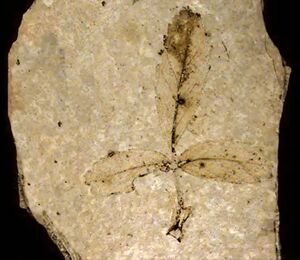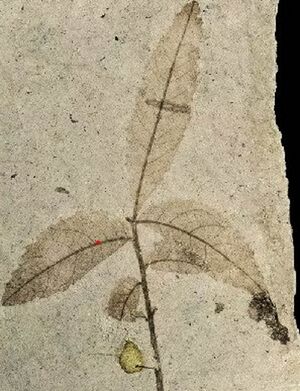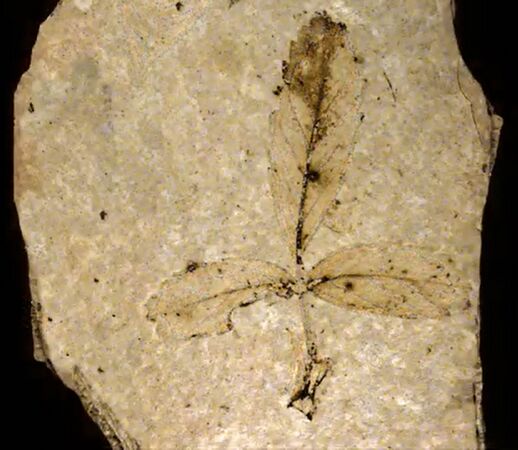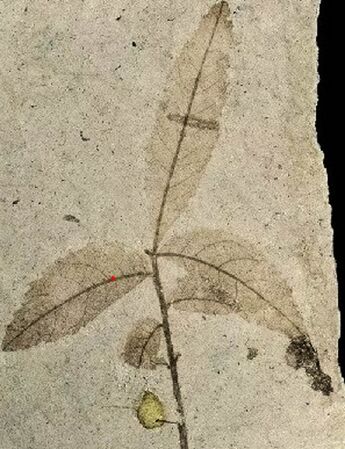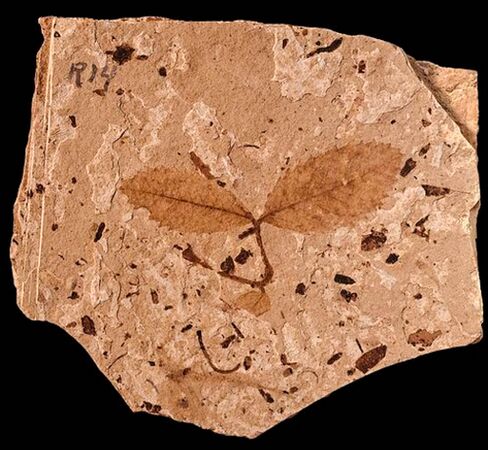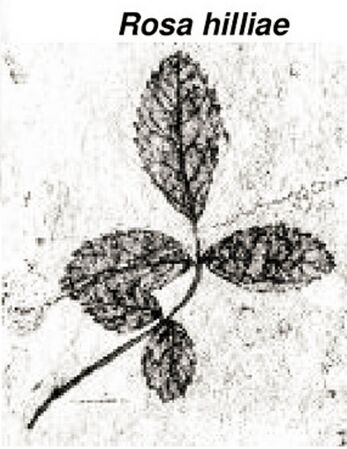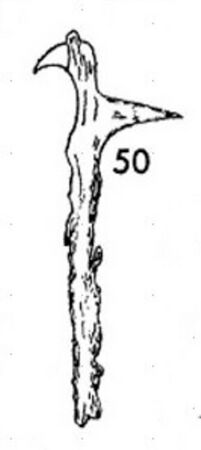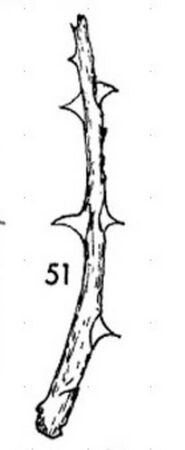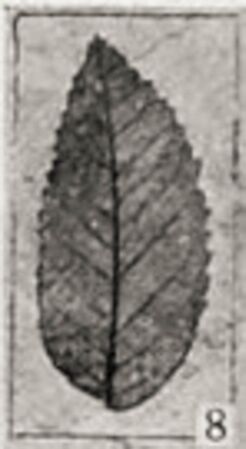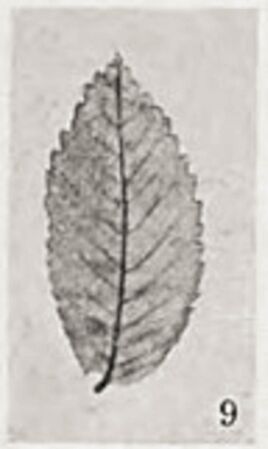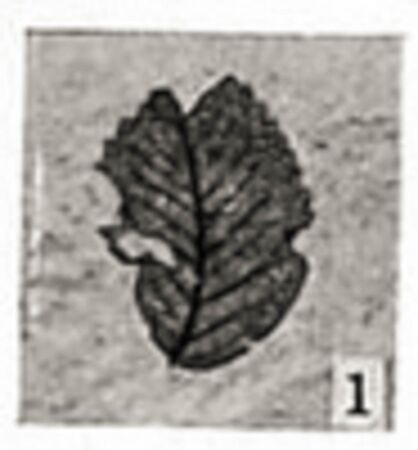Rosa hilliae Lesq.
Fossile-Rose, 1883 - beschrieben vom (Paläo-) Botaniker/ described by the (palaeo-) botanist/ décrit par le (paléo-) botaniste Charles Léo Lesquereux, USA
Eltern/ parentage/ parents: Botanische Rose/ Wild Rose/ Rosier botanique
Die Synonyme wurden beschrieben von den Botanikern/ The synonyms were described by the botanists/ Les synonymes ont été décrits par les botanistes Daniel Isaac Axelrod, USA, Shigeru Miki, Japan, Hermann Engelhardt, Deutschland, Charles Arthur Hollick, USA, Ralph Works Chaney, USA, Frank Hall Knowlton, USA, Gábor (Gabriel) Andreánszky, Ungarn, Oswald von Heer, Schweiz, Theodore Dru Alison Cockerell, USA, Hsen Hsu Hu, China, Toshimasa Tanai, Japan, Władysław Szafer, Polen
Synonyme/ synonyms/ synonymes: Rosa alvordensis Axelrod, Rosa akashiensis Miki, Rosa bohemica Engelh., Rosa cetera Hollick, Rosa confirmata Hollick, Rosa harneyana R.W.Chaney et Axelrod, Rosa inquirenda Knowlt., Rosa legányii Andr., Rosa lignitum Heer, Rosa miocenica Axelrod, Rosa polyantha Sieb. & Zucc. (Siebold et Zucc), Rosa ruskineana Cockerell, Rosa scudderi Knowlt., Rosa shanwangensis Hu & R.W.Chaney, Rosa usuyensis Tanai, Rosa wilmattae Cockerell, Rosa sp. Bánhorvati Szafer
Allgemeines • Preface • Remarques
Diese fossile Rose wurde vor 1883 von der Amateur-Paläonthologin Charlotte Hill[1] in den Florissant Fossil Beds[2] in Teller County, Colorado USA gefunden und vom Botaniker Charles Léo Lesquereux beschrieben und ihr zu Ehren benannt. Der Fundort ist im Oligozän[3] und damit vor 33,9 bis 23,03 Millionen Jahren entstanden.
Nur in Deutschland, im Rheinischen Braunkohlerevier wurde bereits früher der Blattabdruck einer fossilen Rose gefunden, Rosa dubia, 1853 vom Arzt und Paläobiologen Carl Otto Weber beschrieben. Diese Lagerstätte mit fossilen Einlagerungen entstand im Miozän[4], d.h. vor ca. 23,03 Mio. Jahren, d.h. der Abdruck ist also deutlich jünger, als der von Rosa hilliae.
This fossil rose was found before 1883 by the amateur palaeontologist Charlotte Hill[1] in the Florissant Fossil Beds[2] in Teller County, Colorado USA and was described by the botanist Charles Léo Lesquereux and named in her honour. The site was discovered in the Oligocene[3] and thus between 33.9 and 23.03 million years ago.
Only in Germany, in the Rhenish lignite mining area, was the leaf imprint of a fossil rose, Rosa dubia, described in 1853 by the physician and palaeobiologist Carl Otto Weber, found earlier. This deposit with fossilised deposits was formed in the Miocene[4], i.e. around 23.03 million years ago, which means that the imprint is significantly younger than that of Rosa hilliae.
Cette rose fossile a été découverte avant 1883 par la paléonthologue amateur Charlotte Hill[1] dans les Florissant Fossil Beds[2] dans le comté de Teller, Colorado USA. Elle a été décrite par le botaniste Charles Léo Lesquereux et nommée en son honneur. Le site a été découvert à l'Oligocène[3] et donc il y a 33,9 à 23,03 millions d'années.
Ce n'est qu'en Allemagne, dans le bassin de lignite rhénan, que l'on a trouvé plus tôt l'empreinte de feuille d'une rose fossile, Rosa dubia, décrite en 1853 par le médecin et paléobiologiste Carl Otto Weber. Ce gisement avec des dépôts fossiles s'est formé au Miocène[4], c'est-à-dire il y a environ 23,03 millions d'années, c'est-à-dire que l'empreinte est donc nettement plus récente que celle de Rosa hilliae.
Originale Beschreibung • Original description • Description originale
Übersetzung:
Rosa hilliae, sp. nov.
Plate XL, Figs. 16, 17.
Die Blätter sind klein; die Fiederblättchen sind oval, stumpf oder kurz zugespitzt, gesägt; die Nebenblätter sind groß, lanzettlich, zugespitzt; die Nervatur camptodrom.
Diese schönen kleinen Blätter repräsentieren diese Gattung deutlicher als alle anderen fossilen Blätter, die ihr bisher zugeordnet worden sind. Die Fiederblättchen sind eher stumpf, die seitlichen viel kleiner, 5 bis 15 Millimeter lang, 3 bis 7 Millimeter breit - alle kurz geädert wie die endständigen; die Nervatur ist camptodrom, die Abbildung zeigt sie meist craspedodrom, ein offensichtlicher Fehler, denn wie auf der linken Seite des größten Fiederblättchens, Abb. 16, zu sehen ist, sind die Adern gebogen. Die Nervatur in der Nähe der Ränder ist bei den Exemplaren nicht ganz deutlich.
Hab. - Florissant. Princeton Museum, Nr. 768. Auch in der Sammlung des U. S. Geol. Expl. von Dr. F. V. Hayden.
Original:
Rosa hilliae, sp. nov.
Plate XL, Figs. 16, 17.
Leaves small; leaflets oval, obtuse or short-pointed, serrate; stipules large, lanceolate, acuminate; nervation camptodrome.
These beautiful small leaves represent this genus more distinctly than any of the other fossil leaves which as yet have been referred to it. The leaflets are rather obtuse, the lateral much smaller, 5 to 15 millimeters long, 3 to 7 millimeters broad — all short-pediceled like the terminal ones; the nervation is camptodrome, the figure shows it mostly craspedodrome, a mistake evidently, for as seen on the left side of the largest pinnule, fig. 16, the veins are curved. The nervation near the borders is not quite distinct on the specimens.
Hab. — Florissant. Princeton Museum, No. 768. Also in the collection of the U. S. Geol. Expl. by Dr. F. V. Hayden.
Traduction:
Rosa hilliae, sp. nov.
Plate XL, Figs. 16, 17.
Feuilles petites ; folioles ovales, obtuses ou à pointe courte, dentelées ; stipules grandes, lancéolées, acuminées ; nervation camptodrome.
Ces belles petites feuilles représentent ce genre plus distinctement que toutes les autres feuilles fossiles qui lui ont été attribuées jusqu'à présent. Les folioles sont plutôt obtuses, les latérales beaucoup plus petites, 5 à 15 millimètres de long, 3 à 7 millimètres de large, toutes courtement piquetées comme les terminales ; la nervation est camptodrome, la figure la montre surtout craspedodrome, erreur évidente, car comme on le voit sur le côté gauche de la plus grande pinnule, fig. 16, les nervures sont courbées. La nervation près des bords n'est pas tout à fait distincte sur les spécimens.
Hab. - Florissant. Musée de Princeton, n° 768. Egalement dans la collection de l'U. S. Geol. Expl. par le Dr. F. V. Hayden.
Traduit avec www.DeepL.com/Translator (version gratuite)
Fundort • Find location • Lieu de découverte
Diese fossile Rose wurde in den Florissant Fossil Beds[2] in Teller County, Colorado, USA gefunden, sowie auf Gray’s Ranch, im Crooked River Basin[5], 11 miles east of Post, Oregon[6] (letzte 4 Bilder).
This fossil rose was found in the Florissant Fossil Beds[2] in Teller County, Colorado, USA, and at Gray's Ranch, in the Crooked River Basin[5], 11 miles east of Post, Oregon[6] (last 4 pictures).
Cette rose fossile a été trouvée dans les Florissant Fossil Beds[2] dans le comté de Teller, Colorado, États-Unis, ainsi qu'à Gray's Ranch, dans le Crooked River Basin[5], 11 miles east of Post, Oregon[6] (4 dernières photos).
- Rosa hilliae
Zum Vergrößern anklicken • click to enlarge • cliquez pour agrandir
↑ Nach oben • Top • Vers le haut ↑
Einzelnachweis • Footnotes • Notes
- ↑ 1,0 1,1 1,2 Wikipedia, en - Charlotte Hill
- ↑ 2,0 2,1 2,2 2,3 2,4 2,5 Wikipedia, de, en, fr - Florissant Fossil Beds
- ↑ 3,0 3,1 3,2 Wikipedia, de, en, fr - Oligozän
- ↑ 4,0 4,1 4,2 Wikipedia, de, en, fr - Miozän
- ↑ 5,0 5,1 5,2 Wikipedia, de, en, fr - Crooked River
- ↑ 6,0 6,1 6,2 Wikipedia, en - Post, Oregon
Weblinks • External links • Liens externes
- Geosociety, Florissant Fossil Beds - Rosa hilliae, Charlotte Hill, Léo Lesquereux
Literatur • Literature • Littérature
- Leo Lesquereux, Contributions to the fossil flora of the western territories .. Seite 199 - Text u. Plate XL, Fig. 16, 17
- Remington Kellog, John C. Merriam, Chester Stock, Ralph W. Chaney, H. L. Mason, Additions to the Palaeontology of the Pacific Coast and Great Basin Regions of North America, 1927 Seite 123 - Text u. pl. 13, figs. 8-10, pl. 14, fig. 1
- R. W. Chaney & Daniel I. Axelrod, Miocene and Pliocene Floras of Western North America, 1959 Seite 263
- Herman F. Becker, The fossil record of the genus Rosa, 1963 English and German translation
